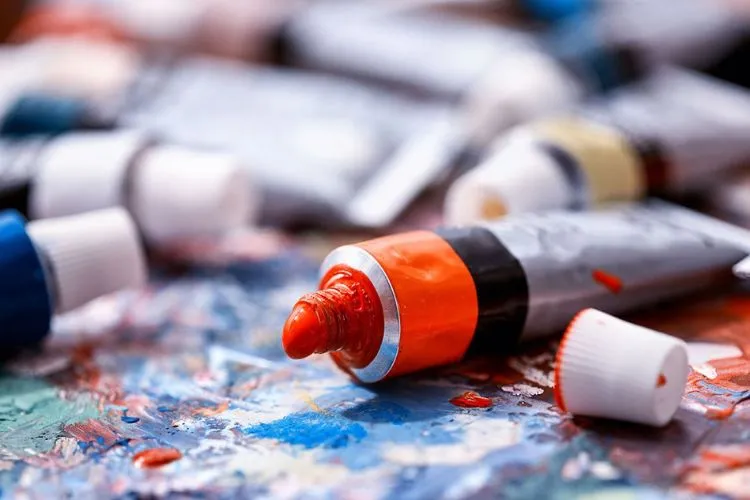Art is a practice that unites creativity with materials, where the artist’s studio becomes a realm of endless possibilities. Among the diverse mediums available, acrylic paints hold a prestigious spot for their versatility and vibrant outcomes.
However, with the use of these paints, arises a crucial question of safety and health: Does acrylic paint need ventilation?

What is Acrylic Paint?
Acrylic paint is a fast-drying paint made of pigment suspended in acrylic polymer emulsion. Artists favor it for its ability to mimic watercolors, oils, and gouache, yet dry much quicker and remain water-resistant.
The ingredients in acrylic paints, from the pigments to the additives that enhance texture and drying time, can influence not just the aesthetics of art but also the air quality of a studio.
You may find useful: How to Make Acrylic Paint Dry Faster?
Does Acrylic Paint Need Ventilation?
Not all that shines is safe, and this is true for acrylic paints. Despite their non-toxic labels, some acrylic paints release fumes that can be harmful over time.
Chemicals, such as ammonia and formaldehyde, can be present in acrylic paints and pose risks to health, especially in poorly ventilated spaces.
These can lead to respiratory issues, headaches, and allergies with prolonged exposure. Therefore, understanding and implementing adequate ventilation is not optional; it’s necessary.
Setting Up a Ventilated Workspace
Ensuring fresh air in the studio is paramount for artists working with acrylic paints. A well-ventilated workspace supports the dilution and expulsion of potentially harmful airborne particles. This can be achieved through various means:

- Natural Ventilation: Simply opening windows can introduce a cross-flow of air that can significantly improve air quality.
- Mechanical Ventilation: Exhaust fans and air purification systems can help maintain a flow of clean air, especially in spaces where opening a window isn’t viable.
- Adapting the Workspace: Artists can make simple adjustments, like positioning their easel near an open window or using a table fan to direct the flow of air outwards.
It’s about creating a balance that allows the enjoyment and exploration of acrylic paints without compromise to health.
Safety Practices While Painting
Beyond ventilation, there are several actions artists can take to minimize risks:
- Personal Protective Equipment (PPE): Wearing gloves, masks, and sometimes goggles can significantly reduce exposure to harmful substances.
- Proper Paint Handling: Knowing how to store and dispose of acrylic paints and their byproducts properly is fundamental. Also, keeping the workspace clean and free from paint spills reduces the risk of inhaling dried paint particles.
Additional Considerations
The conversation around safety and acrylic paints does not end with personal protective measures. Being aware of legal and environmental regulations helps in making informed choices, not just for personal health but also for the larger ecosystem.
Furthermore, embracing a routine of health checks can ensure that the joy of painting today does not become a health concern tomorrow.
Health Impacts of Acrylic Paints

Short-Term Effects of Exposure
Short-term exposure to acrylic paints can lead to immediate but mild health complaints. Users may experience irritation in the eyes, nose, or throat due to the fumes, especially in poorly ventilated spaces.
Headaches, dizziness, and nausea are also common reactions. For those with asthma or other respiratory conditions, exposure can exacerbate symptoms, leading to increased discomfort and the need for medical intervention.
Long-Term Health Risks
Continuous exposure to certain chemicals found in acrylic paints over an extended period can have more serious, long-term health implications. Prolonged inhalation of paint fumes can contribute to chronic respiratory conditions, allergic reactions, and an increased risk of asthma.
Some studies suggest a potential link between long-term exposure to certain chemical components in acrylic paints and developmental issues in children, as well as potential carcinogenic effects.
It’s crucial for artists and hobbyists alike to be aware of these risks, prioritizing well-ventilated workspaces and employing protective gear to mitigate exposure.
Future of Safe Art Practices
Innovations in Non-Toxic Art Materials
The art supply industry is continually evolving, with growing demand for safer, non-toxic materials. Innovations include the development of acrylic paints that replace harmful solvents with water-based alternatives, reducing volatile organic compounds (VOCs).
Companies are also exploring the use of natural pigments and sustainable resources to further reduce the ecological footprint and health risks associated with art materials.
Anticipating Changes in Health and Safety Regulations
As awareness of the health impacts associated with traditional materials increases, regulatory bodies are likely to tighten safety standards. Future regulations may demand clearer labeling, restrict certain chemicals, and push for greener alternatives in art supplies.
Artists and manufacturers must stay informed about these changes to comply and help drive the industry towards safer practices, ensuring that creativity can flourish in environments devoid of health hazards.
Frequently Asked Questions (FAQs)
Do all types of acrylic paints require ventilation?
Yes, all acrylic paints, regardless of their brand or composition, benefit from good ventilation. While the level of toxic substances may vary, ensuring airflow helps maintain a healthy working environment.
What are the signs of inadequate ventilation when using acrylic paints?
Noticing a strong smell of paint, developing headaches, or feeling dizzy during or after painting can signal poor ventilation. Long-term exposure without adequate air exchange may lead to more severe health issues.
Are there any acrylic paints that are safer or ‘odorless’?
Some acrylic paints are marketed as low-odor or non-toxic, but even these should be used in well-ventilated spaces. While they might minimize exposure to harmful chemicals, ensuring clean air is always a best practice.
Conclusion:
The beauty of acrylic painting should not come at the cost of the artist’s health. While acrylic paints offer a versatile medium for creativity, they also require respect for the ingredients they contain.
Adequate ventilation, combined with safety practices, ensures that the art studio remains a place of inspiration rather than harm.
As artists continue to push the boundaries of creativity, recognizing and addressing the need for clean air in their workspace is essential. The harmony between art and safety begins with understanding the risks and taking the necessary steps to mitigate them.

Meet Isabella Anderson, your acrylic painting mentor with over a decade of brush-wielding mastery. Dive into the colorful world of acrylics with her expert guidance, featured exclusively on ‘Acrylic Authority.’ Unleash your inner artist and explore the limitless possibilities of this versatile medium alongside a true acrylic aficionado.
